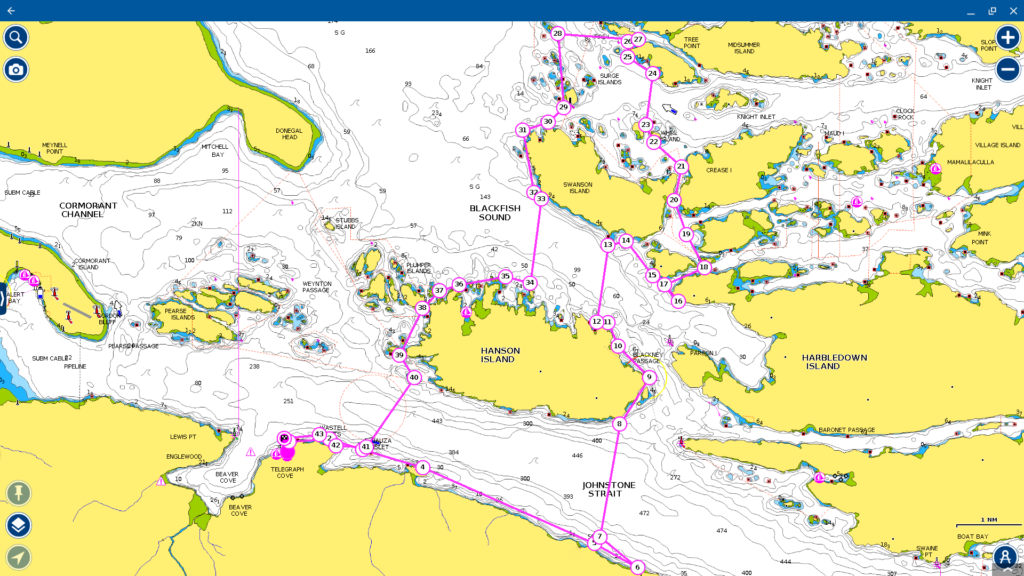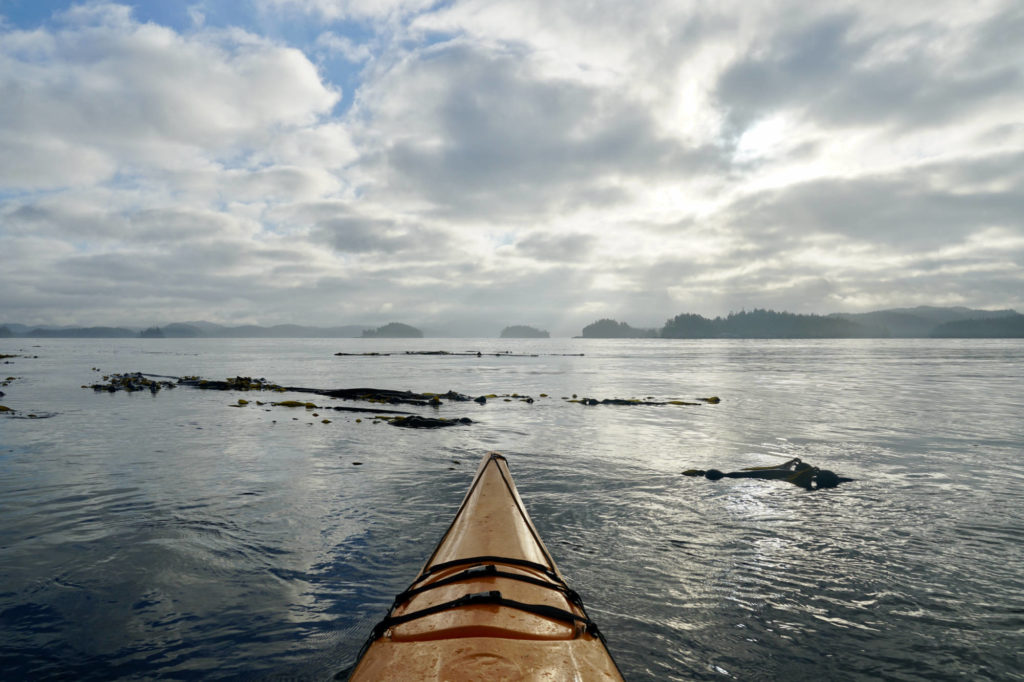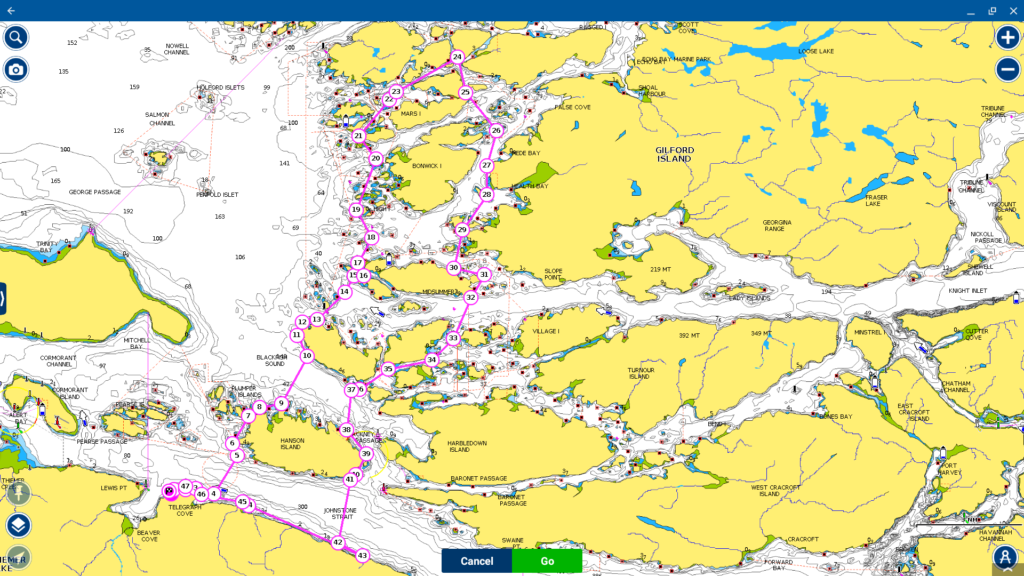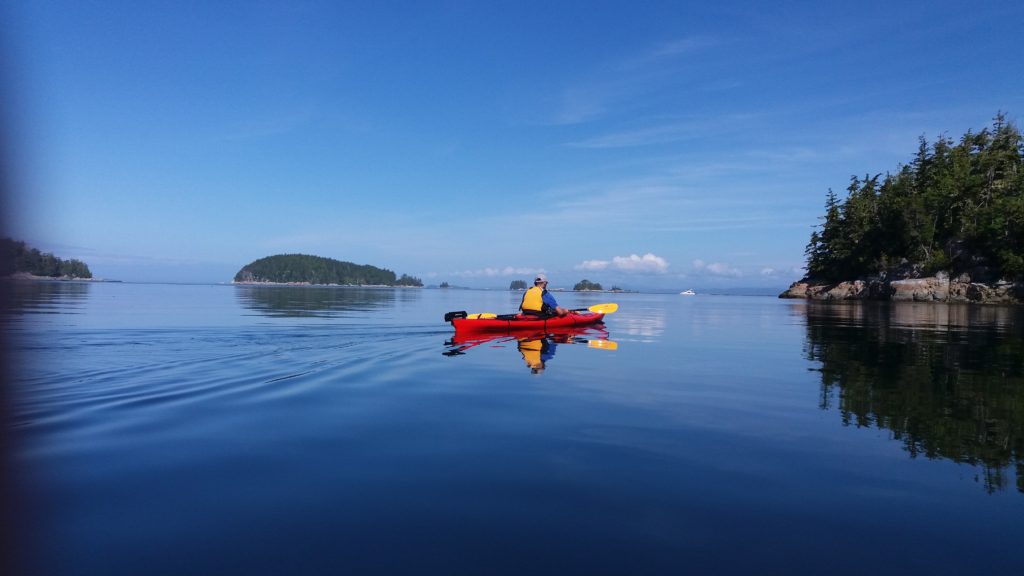Kayaking Johnstone Strait: 5-Day Self-Guided Itineraries

For experienced paddlers, a 4-night, 5-day self-guided sea kayaking tour of Johnstone Strait will get you off the beaten path, and deeper into the remote reaches of the Broughton Archipelago. With that much time on the water, you’ll have a good chance of seeing humpback whales, orcas, pacific whitesided dolphins and land animals such as bears, bald eagles and black-tailed deer. You’ll also begin to experience the tranquility and rhythms of this rugged coastline, spending your days by the ebb and flow of the tides.
These two itineraries are a continuation from the weekend trips, and take in slightly different routes and sights for sea kayaking the Broughton Archipelago. The advanced route covers more distance than the intermediate route and is most suitable for very experienced paddlers.
We suggest renting kayaks in Telegraph Cove as it is the most convenient base from which to begin multi-day sea kayaking trips to Johnstone Strait. While any self-guided tours from Telegraph Cove require prior experience, for those wishing to improve their skills before setting out, we suggest self-guided kayaking training courses. Resupply and full trip outfitting services are possible too.
Itinerary 1–Intermediate Johnstone Strait Kayaking Trip
Day 1: Telegraph Cove to Kaikash Creek (7 nautical miles)
Kayaking from Telegraph Cove, travel east through the Wastell Islets, a beautiful intertidal area with rich invertebrate life, stopping at Blinkhorn Peninsula for lunch and a hike to a nice viewpoint if time allows. Continue along Vancouver Island keeping an eye out for orcas, humpbacks and pacific whitesided dolphins. Plan to visit the border of the Robson Bight Ecological Reserve and set up camp at Kaikash Creek.
Hazards:
- Vessel traffic, wildlife, weather/environment
Day 2: Kaikash Creek to Red Point (7 nautical miles)
Paddle West along Vancouver Island for a little while to shorten the trip across Johnstone Strait and then begin crossing to the southeast point of Hanson Island. Kayak through Kingfisher Pass, and look for nesting bald eagles near Licka Point. The kelp forests here are stunning and a great place to spot sea lions and Dall’s porpoises. Orcas are frequently seen here too.
Paddle the shoreline west towards Orca Lab and Burnt Point, then cross Blackfish Sound from Burnt Point to Flower Island. The small bay near Orca Lab or Flower Island will make a nice spot to stop for lunch. From Flower Island, kayak East towards Red Point, at the northwest tip of Harbledown Island. This area, Parson Bay, is one of the best places in the Broughton Archipelago to spot humpback whales from a kayak.
The campsite at Red Point features a small sand and pebble beach, for an easy landing. Set up your tent and string a hammock in the forest and make your kitchen on the beach. There’s no freshwater here, so bring enough. Latrine is in the intertidal zone. The sunsets here over Blackfish Sound are stunning, and this also a great spot for whale watching from shore.
Hazards:
- Crossing Johnstone Strait, vessel traffic and weather
- 5+kts current at Blackney Pass/Licka point must be timed for slack tide, arrive 30 minutes before slack
- Crossing Blackfish Sound
- West Passage and Whitebeach Passage can have some strong current.
Day 3: Red Point to North Owl (5.5 nautical miles)
From Red Point head into Whitebeach Pass, rounding Compton Island, and paddle towards Crease Island and then into Swanson Passage. Be sure to visit the petroglyphs at ‘The Chief’s Bathtub’ on the north side of Berry Island, a Mamalilikulla First Nations Cultural Site. Here is a natural rock basin that fills at high tide. Legend tells of a local chief bathing here, the water warmed with stones heated in a fire.
Mound Island is also worth visiting for its massive midden site. From Swanson Pass head northwest to Whirl Island, then continue North to Owl Island and make it to the northwest side of Owl Island to camp.
The landing here is a pebble and rock beach at high tide, but very slippery and rocky at low tide. Set up your camp in the forest and your kitchen on the beach or the forest. There is an outhouse here. No fresh water is available. As this is an easy paddling day, after setting up your camp, get back on the water and explore the area around Owl and Cedar Islands, and venture out into Canoe and Sledge Islands. The west beach on Owl Island has very nice sunsets.
Hazards:
- Current in Whitebeach Passage
Day 4: North Owl to Pool Point – (7.5 nautical miles)
From leaving camp, paddle west aiming for the White Cliff Islets, a stunning spot for photos. The small rocky islets in this area are home to many seabirds and sea lion rookeries. From the White Cliffs, begin to kayak south through all the small islets towards the northwest shore of Swanson Island, and around Bold Head. Keep an eye out for orcas and humpbacks as you round Swanson; they’re often spotted here. Continue to paddle towards Flower Island. Cross Blackfish Sound from Flower Island to Burnt Point then west along Hanson towards Pool Point.
The north side of Hanson Island has many secluded beaches and coves that are perfect for lunch breaks. The campsite at Pool Point is a rocky landing, which is very slippery at low tide. Set up your tent in the forest, but be aware that space is limited at this site. Kitchen can be set up in the forest or on the beach. There’s no freshwater and the latrine is in the intertidal zone. There are great viewpoints over Blackfish Sound and stunning sunsets at Pool Point. Also, consider a night paddle in Double Bay, to see the amazing bioluminescence by kayak in this sheltered bay.

Day 5: Pool Point to Telegraph Cove (5.5 nautical miles)
After leaving camp at Pool Point, Head south through the Blowhole (Plumper Islands) towards Weynton Island. From Weynton, paddle towards Turn Point and stop here for a lunch break. Then cross Johnstone Strait to Blinkhorn Peninsula and continue west to Telegraph Cove.
Hazards:
- 5+kts current through Plumpers/Blowhole; pass during or near slack
- Crossing Johnstone Strait
Itinerary 2–Advanced Johnstone Strait Kayaking Trip
Day 1: Telegraph Cove to North Owl Island – (10.5 nautical miles)
Head East out of Telegraph Cove towards Bauza Islet, cross Johnstone Strait from Bauza, heading towards the southwest tip Hanson Island. Paddle into the Plumper Islands and through the Blowhole, continuing along on the north side of Hanson towards Pool Point where you’ll cross Blackfish Sound towards the middle of Swanson Island. Plan for a lunch break in one of the small coves on Swanson’s southwest side. Paddle northwest to Bold Head and explore the tiny islets here as you make your way on to Owl Island.
Hazards:
- Crossing Johnstone Strait, Vessel Traffic and weather
- 5+kts current through Plumpers/Blowhole, pass during slack
- Crossing Blackfish Sound
Day 2: North Owl to Insect Island- (9 nautical miles)
Paddle northwards past Canoe Islet, Sedge, Start, Hudson and Marsden Islands. You are sea kayaking the Broughton Archipelago now. These islands are all worthy of exploring and can make a nice stop for lunch. From Marsden, head northeast into Misty Passage and continue until Insect Island appears. You’ll notice a very distinct white shell beach. Beautiful Islands abound in this part of the archipelago, with intricate passages and colourful intertidal marine life. Whitesided dolphins and porpoises are also commonly spotted here.
The landing at Insect Island is made up of brilliant midden (white shell) beach. Midden beaches are made up from the bones and skeletons of crustaceans, mollusks and mammals that have been harvested and consumed over the years by the First Nations people who once lived here. (Insect Island is part of the Dzawada’enuxw First Nation’s unceded territory.) Each meter of midden equates to approximately one century habitation by the Dzawada’enuxw people. There is limited beach space here so be sure to consolidate kayaks to provide space for others. Set up your campsite and kitchen in the forest. Fresh water is not available here. Latrine is the intertidal zone. Insect Island is one of the nicer campsites in the area to just hang out and read a book and enjoy the natural beauty of the area. The south side of the island is known for its great sunsets.
Day 3: Insect Island to Maggy Point – (11 nautical miles)
Begin paddling southeast through Blunden Passage towards the Fox Group, a pretty cluster of islands well worth exploring. From the Fox Group head south into Retreat Passage, pausing anywhere that looks inviting for a lunch break, then continue south, rounding the east side of Midsummer Island. From there, cross towards Crease Island and paddle along the south shoreline of Crease until you reach Maggy Point on the southwest side of Crease Island.
The landing at Maggy Point features a shell and sand beach. As this is a disused basecamp, there are tent platforms in the forest and a shelter-frame kitchen that just requires a tarp to cover. Freshwater is not available.
Day 4: Maggy Point – Kaikash – (7.5 nautical miles)
Paddle south through West Passage, between Swanson and Compton Islands and then continue west towards Flower Island. Cross from Flower Island to Burnt Point on Hanson, handrail Hanson eastwards, picking any of the pleasant coves as a lunch spot. Keep heading east towards Licka Point, continuing through Kingfisher Pass and rounding the southeast side of Hanson. From there take a south bearing and paddle across Johnstone Strait to Kaikash Creek.
Hazards:
- Currents through West Passage
- Crossing Blackfish Sound
- 5+kts current at Blackney Pass/Licka point; time it with slack tide, arriving 30 minutes early
- Crossing Johnstone Strait, Vessel Traffic and weather

Day 5: Kaikash Creek to Telegraph Cove (7 nautical miles)
You’re back on Vancouver Island, so paddle west hugging the shoreline, stopping at Blinkhorn Peninsula for lunch and a hike to a nice viewpoint if time allows. This stretch of coastline has fantastic intertidal life at low tide, so exploring tide pools or beach combing can be a great activity as well. The kelp beds are dense here, so be on the lookout for harbour seals and sea lions which often patrol these rich habitats in search of food. Eventually you’ll reach Telegraph Cove, back where your trip began.
Additional Resources
Tide Rips and Back Eddies by Billy Proctor
Kwikwasut’inuxw Haxwa’mis First Nation






